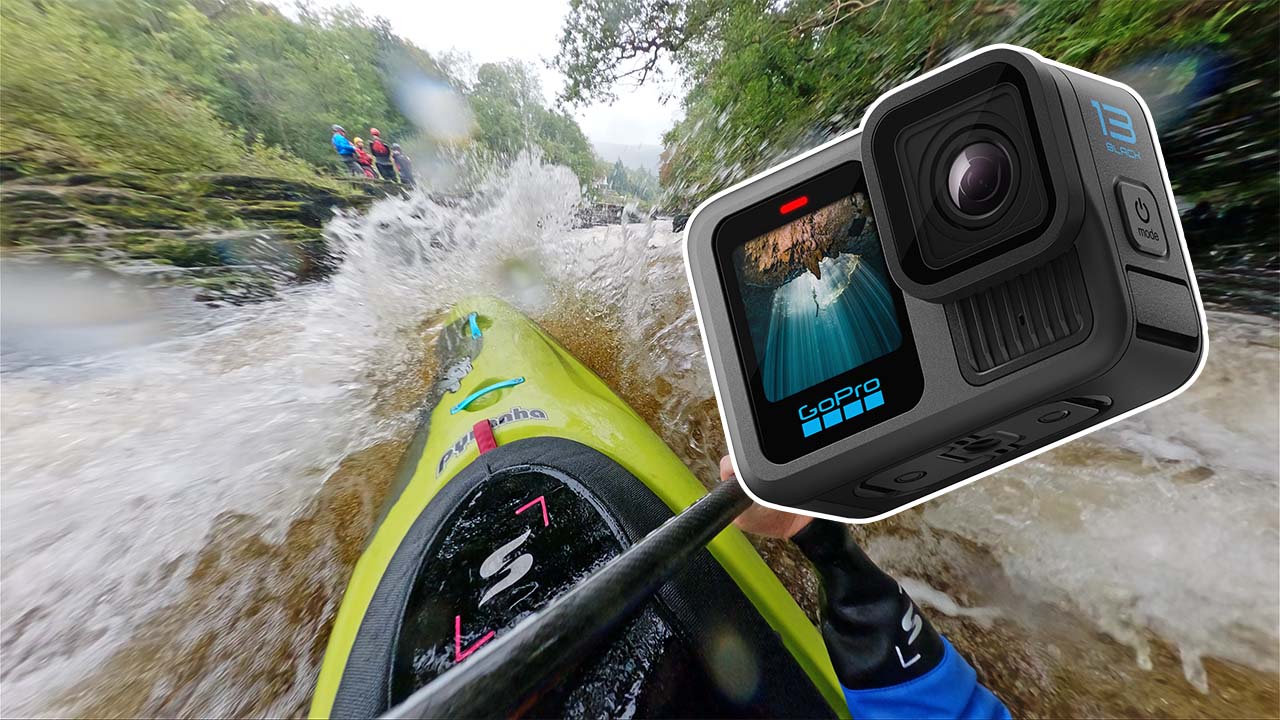
GoPro has released the HERO13 Black, but in an increasingly competitive market space, has it done enough?
It's fair to say that GoPro has not had the best of years, with employee layoffs at the beginning of the year. But, the company is currently embarking on a growth strategy to try and turn things around. Part of that strategy is going to be the release next year of dedicated motorcycle related products, after GoPro purchased smart helmet manufacturer Forcite Helmets last year. There's also the long anticipated release of the MAX 2 360 camera, which is hopefully arriving later this year.
The HERO series of cameras is GoPro's core market however, and the company recently announced two new products, the flagship HERO13 Black and the entry level HERO. With DJI and Insta360 snapping at its heels, there was a lot of speculation about what the 13th version of the HERO Black series would bring to the table.
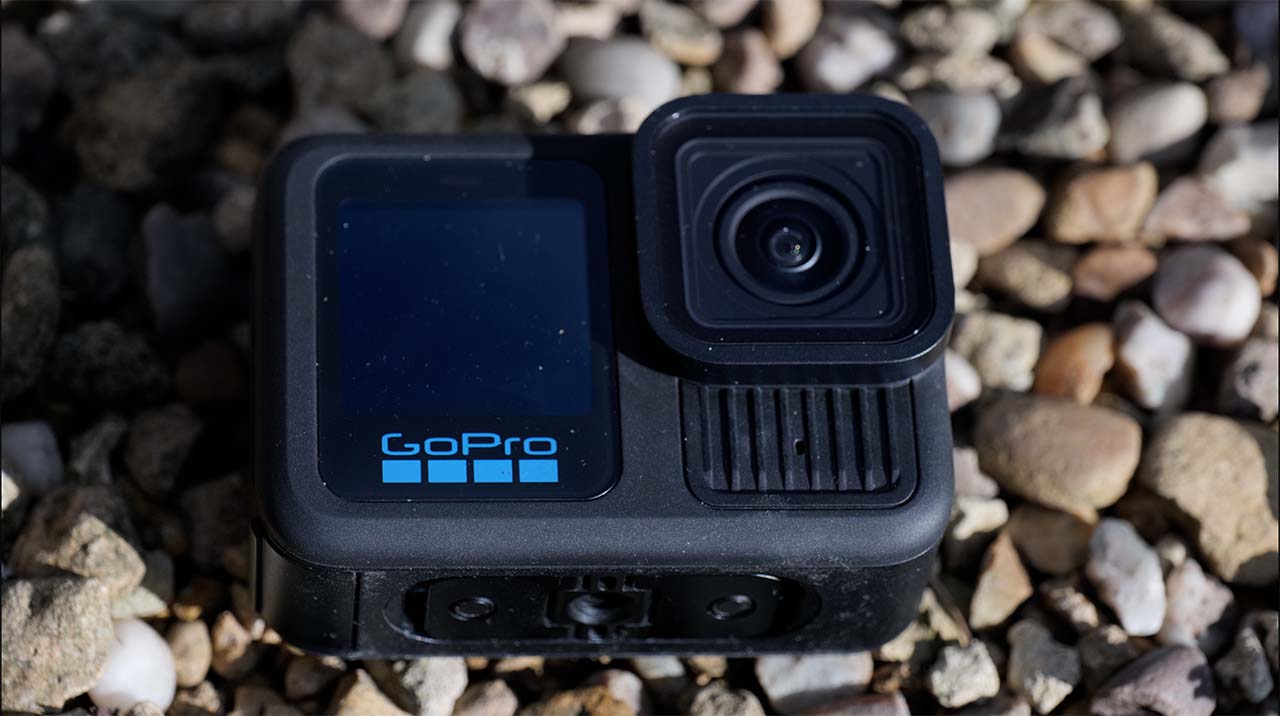
The HERO13 has undergone a slight facelift
What's new?
The HERO13 is very much focused on creators and being able to achieve looks that are different from standard action camera fare. But, let's start from the beginning and take a look at the HERO13 Black from the ground up. But before I do, I should mention that the HERO13 has an Easy Mode that lets more casual users of the camera use it without needing to delve into settings menus. However, the true power of the camera is unleashed once you get into the minutia of the settings, and it's more advanced users that I'll be focussing on for most of this review.
To begin with, the camera body has undergone a slight facelift. The dimensions are the same as the HERO12, but the front LCD display surround has been redesigned, and the front mic is now surrounded by a kind of fin design. Some have speculated that this is some sort of heatsink, but let's be honest, it really isn't.
Inside, there's a new internal compartment to accommodate the new battery design. Reading around, there's has been some backlash regarding the new battery, with some asking why it couldn't have been made compatible with older cameras. The fact is that it has a larger capacity and no longer has the step design at the base, which is likely where the added milliampere hours capacity comes from. As such, it was never going to fit into the older models, and I suspect that this new battery is also part of the roadmap leading to the GP3 processor next year.
Speaking of which, the HERO13 uses the same GP2 processor as the HERO12. As I just alluded to, I believe that this will be the last year we'll see the GP2, other than inside the forthcoming MAX2 360 camera.
There's some new burst slow motion options, which can take short shots of video at up to 400fps with reduced resolution, as well as a true HLG HDR mode and WiFi 6 compatibility for faster footage uploads
The lens mount has changed ever so slightly, with an area reserved for a small notch on the new HB lens range. I suspect that this forms part of how the camera knows which lens mod is attached automatically, but as a result it means that the new lenses are not compatible with the older cameras. Although, you can fit the Max Lens Mod 2.0 onto the HERO13, it's just that it won't automatically recognize it and you'll have to manually tell it that it's attached in the menus.
Indeed, most of the HERO13's new capabilities come via the new lens mods. If you like to use ND filters on your GoPro, the new HB lens range of NDs take all the guesswork out of using them. The camera will tell you if you need a stronger or weaker ND, and you can set it so that you can achieve a balance of motion blur while keeping HyperSmooth stabilization performance, or to go for maximum blur. The latter makes for a great effect if you are taking stills with the camera.
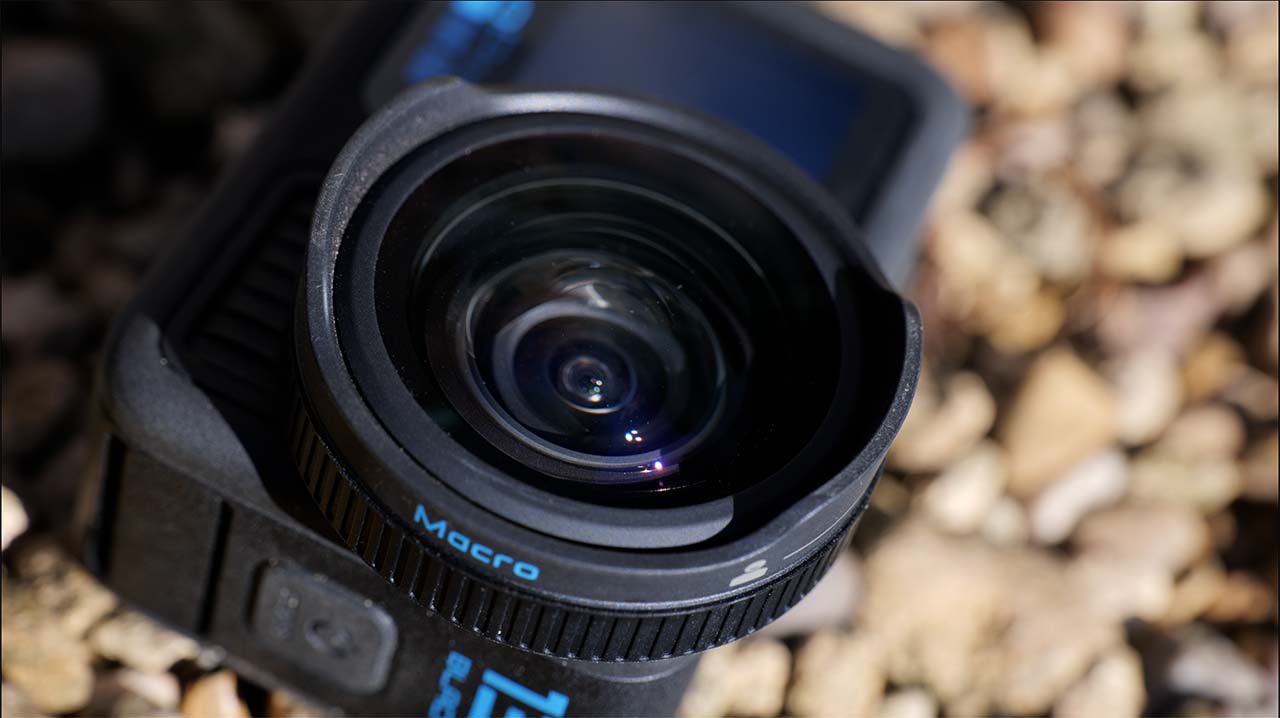
The HERO13 with Macro Lens Mod attached
Macro Lens Mod
The Macro lens, as the name suggests, allows you to film objects at a much closer focus range than normal. It isn't a true macro in that you won't be filming 1:1 ratio shots of insects, but you can achieve angles that would not ordinarily be possible. For example you could mount the camera close to the rear derailleur of your bicycle to see the mechanical movement more clearly. You could also film a selfie vlogging style shot much closer than normal. When the lens is at its closest focus, a subtle background blur is introduced, separating the look from what you'd usually expect from an action camera.
Focus is performed with a manual focus ring, and the camera automatically displays focus peaking assistance. Because the Macro lens retains the GoPro's wide angle of view, it's a lens you could potentially leave on much of the time, because when the lens is at maximum focus distance it behaves much like the standard GoPro lens.
The only caveat is that with the firmware I tested with the camera, it wasn't possible to shoot with the new burst slow motion modes with the Macro lens attached. Although, I could still use 2.7K 240 fps with it.
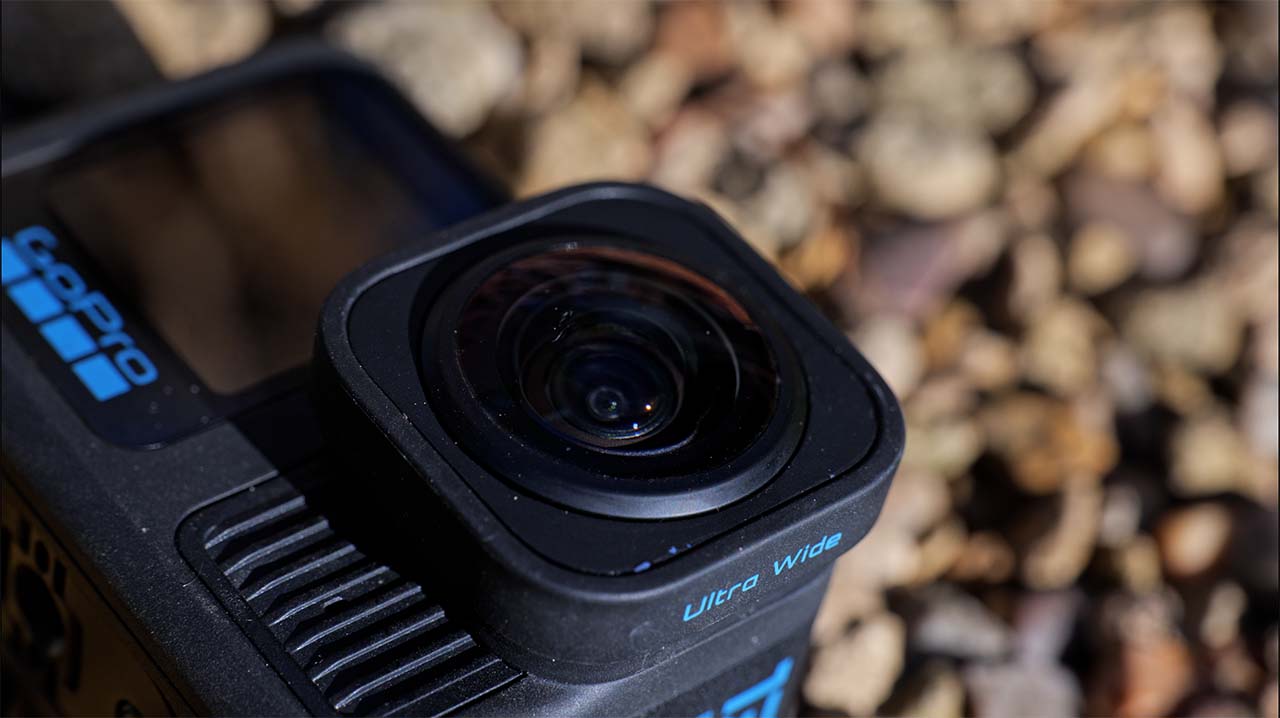
HERO13 Ultra-Wide Lens Mod
Ultra Wide Lens Mod
The Ultra-Wide Lens Mod is similar to last year's Max Lens Mod 2.0, except that it features the addition of auto-recognition. The HERO13 is more flexible than version 12 with the lens mods attached. For example, the GP-log profile can now be used, which wasn't possible with the HERO12 and the Max Lens Mod 2.0. There's also a new 1:1 aspect ratio that's been introduced. This expands the image even more in terms of height than the 8x7 ratio, which you can shoot with the standard lens. 1:1 gives you a true square image, giving you maximum freedom to reframe the image later. It also gives you the widest possible FOV in an action camera outside of a 360 camera.
With the Ultra-Wide Lens Mod attached, if you don't want to perform much post reframing later, you can use a choice of 16:9 digital lens modes, such as Linear, Wide, Ultra-Superview and Ultra-Hyperview. 360-degree horizon leveling can be enabled for all modes with no crop penalty.
For POV I would recommend the Ultra-Superview and Ultra-Hyperview modes. Just as with the Max Lens Mod 2.0, Ultra-Hyperview is best suited when the camera is facing forwards and level due to the distortion that is introduced via its dynamic stretching effect to fill a 16:9 frame. For those who are unfamiliar with it, the Hyperview modes take the full height image of the 8x7 and 1:1 ratios, but dynamically stretch the left and right of the image to fill a 16:9 framing, leaving the center of the image relatively untouched.
For MTB and skiing, Ultra-Hyperview will give you the best sense of speed, as well as allowing more of your skis or arms to show. Ultra-Superview is also a great option, giving a much wider angle of view than the standard camera lens, but with far less distortion than Ultra-Hyperview.
For those who want maximum flexibility and the best results, I recommend using the 1:1 mode and then reframing in post. This can look incredible once it has been processed. For example, I can achieve an absolutely stupendously wide POV shot, and then use the lens distortion correction filter within Resolve. By doing this, I can not only expand the image out to a 16:9 frame, but it also gets rid of any lens curvature effects, while retaining most of the width and height of the image. There's a slight crop penalty, but often it's worth it to achieve the straight lines. With kayaking POV shots this makes a big difference, because the paddle shaft can look unnervingly distorted when using the built in Hyperview modes. However, by using 1:1 mode and then removing the distortion in post, the paddle shaft will look perfectly straight.
However, I would still exercise caution when using the Ultra-wide lens mod for water sports. Despite the hydrophobic coating, lens droplets don't fall off it as easily as the standard lens protector. Additionally, if you scratch it the lens droplets tend to congregate in the damaged area. As a result of this, I've now begun applying a hydrophobic coating like X-Clear to it to give it better hydrophobic qualities.
That said, the Ultra-Wide Lens Mod I've been testing has taken a severe beating and only has minor scratches on the lens to show for it. You have to look very closely in good light to see them. At one point one of the mounts fell off my bike while filming a comparison shot between two cameras, resulting in the rear LCD screen cracking badly. It was a reminder to use screen protectors in one way, but it also demonstrated how resilient the Ultra-Wide Lens mod is. Just as an aside, the other camera's screen was totally nuked, but you'll see more about that in a future review.
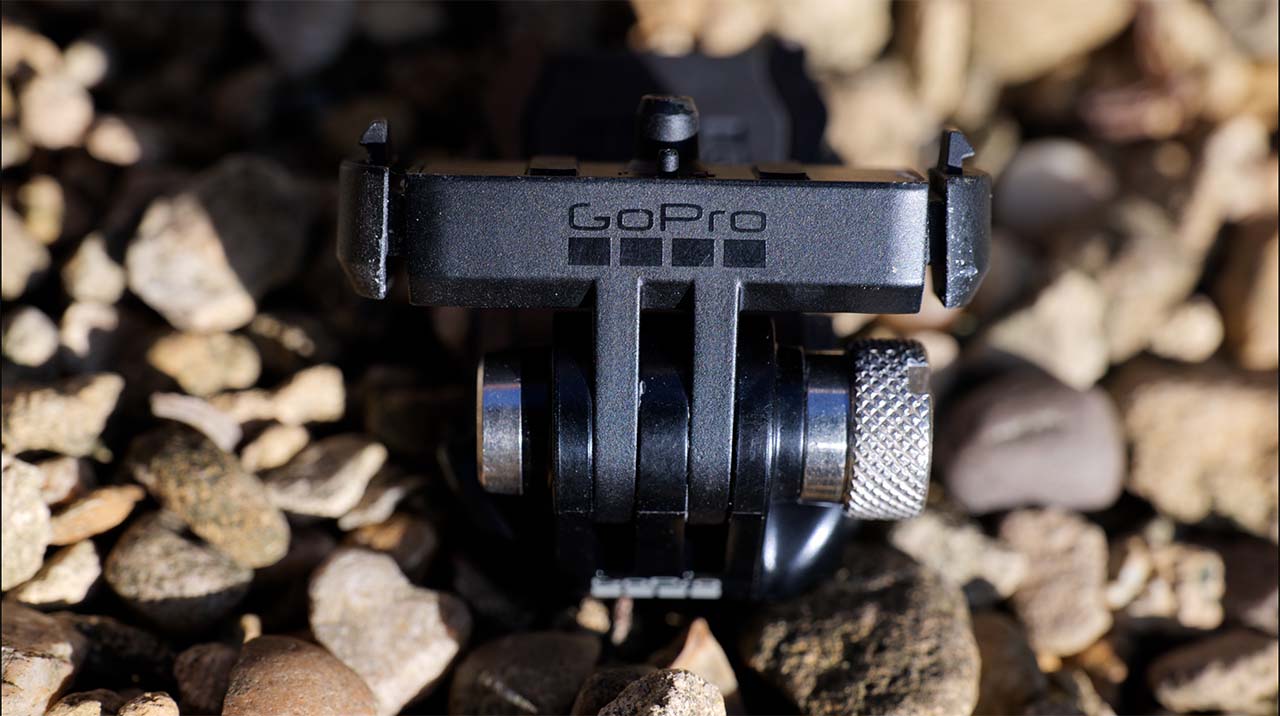
The new magnetic clip mount for the HERO13
Magnetic clip mount system
A hugely welcome addition to the HERO13 is the new magnetic mount system. The traditional foldable fingers still remain, as does the 1/4" screw thread, but now you can use a speedy magnetic system as well. It's been a while coming, but GoPro has listened, and it's here. Thankfully it's also a very well designed system.
For starters, the mount itself is made from metal. It is also bi-directional, so you don't have to be careful to affix the mount in any given direction like you have to with rival systems. Lastly, it's very strong. The side release buttons could be accidentally knocked, much in the way I did with the Insta360 GO3, nearly losing camera in the sea in the process. The difference with the GoPro system is that even if one of the side buttons is knocked and the camera somehow lifts up, it's pretty much impossible to detach the camera unless the second release button is also pressed.
GoPro still recommends that for extreme movement situations, such as high vibration scenarios on a fast moving quad bike for instance, that users still use the traditional finger mount since it can be really cranked down and tightened for zero movement or vibration. But, for 99.9% of the time I see the new magnetic system as the way to go. It just makes life so much easier if you have several places to swap the camera between. The only real drawback is that at over £20 or US Dollars, buying a number of them could get pricey. No doubt we'll see third party versions appearing soon, though sometimes the solidity of those can be questionable unless it's a known quantity such as Ulanzi or Smallrig.
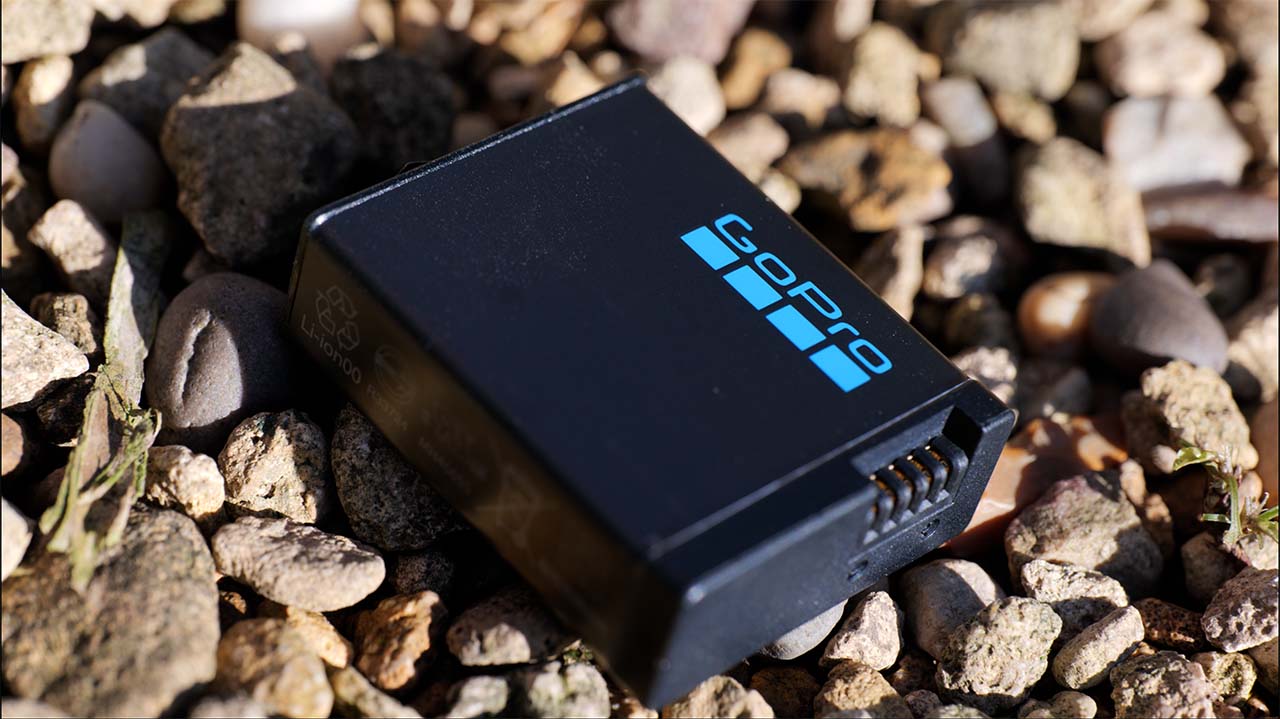
The redesigned Enduro battery with higher capacity
Battery life and power
Okay, so now let's talk about power. The new Enduro battery is 1900 milliampere hours compared to 1750 of the previous one. As I mentioned earlier, it isn't compatible with your older GoPro cameras or charging pods, so yes, you will need to buy some new battery sets. Now, the big question is, what does it do for battery life?
Well, it's a mixed bag, and how much benefit you'll get from it will depend on how you use your camera. The new battery gives its best improvements when it comes to high frame rate modes and situations where there's no airflow over the camera. The camera will still perform a thermal shutdown, particularly in high resolutions and frame rates, but it will go longer before it does so.
I've always been a little dubious about the whole thermal shutdown debate, generally because the situations that the GoPro is designed to be used in are ones where it is moving around outside or in and around water. As I've said in previous videos, I've no doubt that some people have niche uses for GoPros where thermal shutdowns can be an issue, such as inside a race car in hot weather. But, in my own personal experience, using the camera for outside sports and POV, I've never once had any sort of thermal shutdown in a real-world use scenario.
I'm going to put in another caveat here. One thing I believe that holds back the current GoPro cameras is the GP2 processor. Not because it's a bad processor, but because it uses a 10nm fabrication process, which these days is considered, well, a bit chunky. If a future GP3 processor utilises a 5nm or less process, then in conjunction with the new battery I suspect we'll see a HERO14 that not only possesses vast increases in battery life, but also consigns thermal shutdowns to history. I have a real world example of this to prove my point, but again, that's for a future video.
With all that said, the new Enduro battery is an improvement, and I've found myself being far less concerned about battery life when I've been shooting with the camera. For example, on one kayaking trip, because I knew I only had one battery for testing, I was quite selective about when I turned the camera on. By the end of the trip though, I was pleasantly surprised to find that I still had 70% battery life left in it.
One thing I did find disappointing was that there's still no fast charging ability. The camera does charge ever so slightly faster than the HERO12, but it's nothing like the 80% in 15 minutes that we see from rival cameras. This really does need to be addressed in a future product.

A shot taken with the Ultra-Wide Lens Mod in 1:1 ratio, then distortion corrected within Resolve for the ultimate in immersive POV angles
Image quality
So, those are the physical attributes of the HERO13, what about its image quality and reliability?
Because the HERO13 uses the same processor and sensor as the HERO12, you're not going to see huge differences in image attributes such as color and dynamic range, but you do have more control over it out of the box. If you aren't concerned about grading, the natural color profile gives you that out of the box GoPro look; high contrast, and an almost HDR look with high saturation levels. If you are doing a Vlog with no grading, I would recommend the Flat profile, because the Natural profile under some lighting can be extremely unforgiving to facial skin. I know I'm no spring chicken, but under backlit sunlight the natural profile gave me the facial skin profile of a bedraggled bad guy from a Sergio Leone Spaghetti Western movie! For advanced users who will grade, use GP-Log all the way.
One thing I've hoped for in the past is that GoPro would add in the ability to control the noise reduction. Noise reduction in-camera can be beneficial, but in an action camera, particularly if you want to do any grading on the image, it can negatively affect shadow areas, turning them to mush. Thankfully GoPro has now included this option on the HERO13 and users can choose between low, medium, and high settings. If you're a casual user, medium will give you the best balance. But, if you're using GP-Log and grading later, you'll absolutely want to turn the setting to low and perform any noise reduction in post.
It appears that GP-Log uses the wide color gamut natively, and you have to be in a 10-bit color mode to use it. Therefore, if you use GP-Log with the noise reduction set to low, along with the low sharpness setting as well as boosting the recording bitrate using the Labs firmware, you'll achieve the most gradable image out of the camera possible. Bear in mind that GP-Log, like most log modes on cameras, is not best used in low light situations, such as in a dingy forest when the sun is going down.
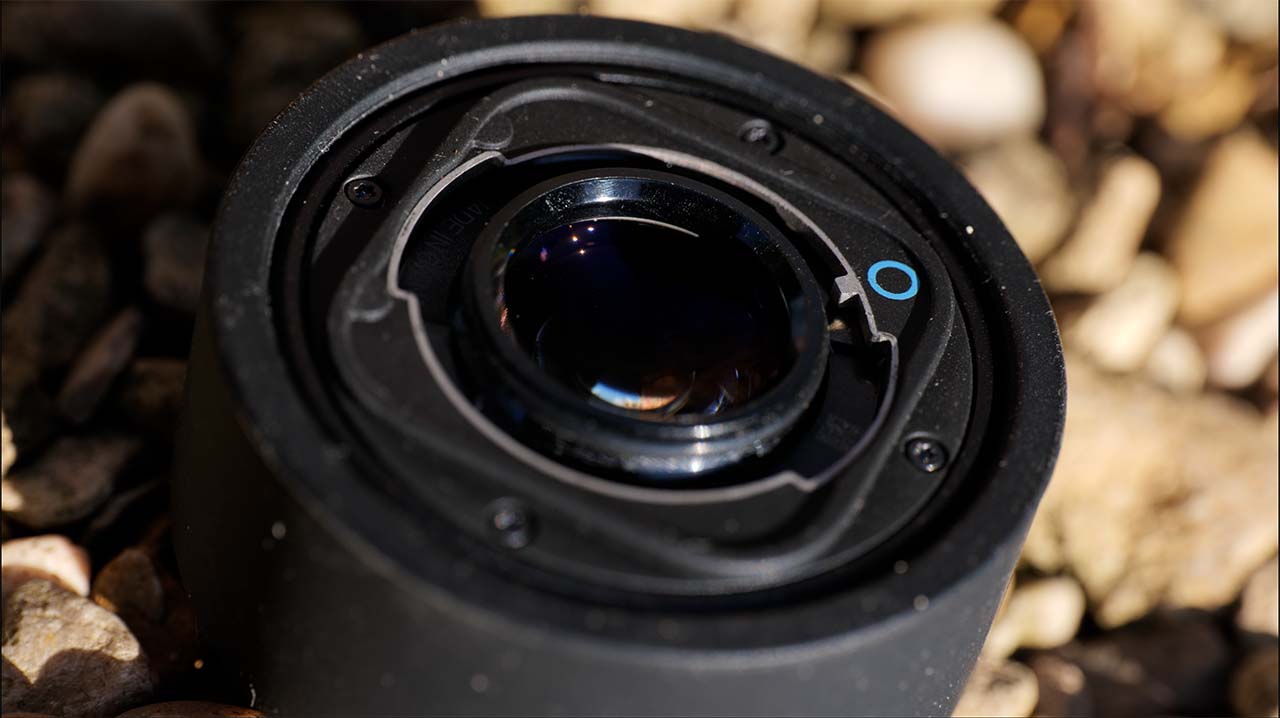
The rear of the Macro Lens Mod, showing the additional 'notch'
Slow motion
Slow motion on the camera is now expanded with the new burst modes. Now, it's of note that while you can use GP-Log with 4K 120fps slow motion, you can't use GP-Log with the burst slow motion modes. In burst modes you can record 15 seconds of either 900p at 360fps or 720p at 400fps. You can also record 5 seconds of 120fps footage at 5.3K resolution. With regard to the 360fps and 400fps modes, while there is a noticeable loss of resolution, they actually look pretty damn good, particularly in decent lighting conditions. Upconverting via an app like Topaz will also help with incorporating the shots with other cameras. Quite often, this type of shot is for the Instagram, and on a phone screen they look great without the need for up-conversion. I'm a sucker for super slow motion modes, even with reduced resolution.
As one aside, I will say that burst slow motion mode wasn't available at the time of review while the HB lens mods were attached. Although I have seen a video from GoPro showing off 400fps slow motion with the Macro Lens, so perhaps it's coming in a future firmware.
Audio
With regards to audio, the camera now has the option to select a general recording, which places equal emphasis on all sounds, or a voice focussed mode, that aims to focus on your voice while still incorporating ambient sounds. I have to admit that I didn't really notice a huge difference and wind noise can still be an issue at times. Your best results will always come from a separate mic or attaching a wind screen to the GoPro body. But, out of the box it seemed to handle things okay.
You can now connect to the DJI Mic 2 via Bluetooth. While some aspects of the recording will improve by doing this, a hit will be taken elsewhere. The DJI Mic 2 sends audio at 16Khz over non-DJI wireless connections, which means less than stellar clarity. This isn't GoPro's fault, but just something to consider if you were hoping to use this mic with the HERO13. If GoPro was to make its own wireless mic that could transmit to the camera at 48Khz, and record separately to the mic's own storage in 32-bit float, and was waterproof with some sort of clever built in water resistant windscreen, it would have a pretty dead cert winner on its hands! It would be the first true outdoors adventure microphone to take on all conditions.

The neatly packaged set of ND filters
Reliability
Reliability wise, the HERO13 has been very consistent. A lot of freezing issues with GoPros come from a bad SD card, or counterfeit cards. I've been using an Angelbird 256GB V60 card rated at 280MB/s, which is overkill, but the better the card you can get, in my experience the more reliable things will be. I've been using the camera mostly using the Quick Capture mode, which means that you press record to turn the camera on and start recording automatically. If you press record again, the camera will stop and turn itself off. On the HERO13 you now have five seconds to press record again to carry on recording, or to press the power/mode button and halt the power down. So far it has worked very well for me and hasn't crashed.
My only issue with the camera in terms of robustness was the fragility of the rear LCD screen when it bit the dust falling off my bike. Use a screen protector! It might not prevent a smashed screen in all cases, but it will reduce the chances of it. That said, this is the first time I've ever smashed the screen on a GoPro, but I've always known it to be a risk to be conscious of.
Conclusions
So, in conclusion, should you get a GoPro HERO13 Black? A lot of reviews talk about new camera releases through the lens of whether you should upgrade from last year's model, and I find it to be a rather slanted way of looking at things. Most people who buy a £400 camera won't be looking to upgrade every year. If you are a truly advanced user who makes a living from using these devices, and they make their money back very quickly, then upgrading year on year might be a consideration. But for the vast majority of users, this won't be something they'd entertain.
Instead, let's look at the HERO13 in isolation. Let's imagine this is your first action camera, or you own an older GoPro such as the HERO8, 9, 10 or older and you use your camera a fair bit.
The main decision will come down to whether you are a casual shoot-and-forget type of person or an advanced creative user who wants to get the maximum image quality possible from an action camera. For casual users, GoPro has also announced the HERO, which is designed to cater for people who just want something they can easily record their adventures with, with no fuss. Although the HERO13 has an easy mode for non techy users, as a device it is very much aimed at people who want to maximize the image they can squeeze out of an action camera. For example, the new lens mods are for people who want to do much more than simple POV angles and selfie stick shots.
We also have to look at the alternatives. With DJI now firmly on the action camera block, there's some very real competition to take heed of. So, what does the HERO13 have going for it over its current market rivals?
For advanced users there's the sheer flexibility of the image settings. The new magnetic mount is the most solid that I've tried so far, as well as being more flexible due to its bi-directionality. The HERO13 is also the only action camera that can use a magnetic mount, a traditional GoPro style finger mount, and a 1/4" screw mount right out of the box. While not everyone will be using the lens mods, the added creativity and flexibility they give is a definite plus for more creative users, particularly given the automatic recognition system. The availability of the Labs firmware is also unique to GoPro and gives the camera capabilities that are simply not available anywhere else.
Then there are the 8:7 and 1:1 aspect ratios, which, because we are currently in generation TikTok, are the most flexible ways of shooting footage for a 16:9 wide ratio and 9:16 vertical ratio simultaneously. Rival cameras require the physical re-orientation of the camera, or the 4:3 ratios they offer don't have the same resolution or flexibility for reframing. So, this is also another notable advantage of the GoPro.
If I could sum it up succinctly, the HERO13 has become the creators action camera. It's the one to get if you want to shoot more than the usual cliched action camera style shots, but you still want to be able to do it in all conditions, and capture new types of shot for your given sport or activity. If we talk about the base camera alone without considering the lens mods, the HERO13 is still one of the best action cameras around. So far it has been reliable for me, and the new magnetic mount makes things so much more convenient for swapping locations. If you just want to capture footage without fuss, and you're upgrading from an older GoPro, then the HERO13 will represent a leap in capability.
Would I recommend the HERO13 over the Osmo Action series? That's one of the toughest questions to answer, and it's not one I can really answer for you. As per always with these things, it all depends on how you use the camera, and only you can answer that for yourself.
Tags: Production Action cameras


Comments